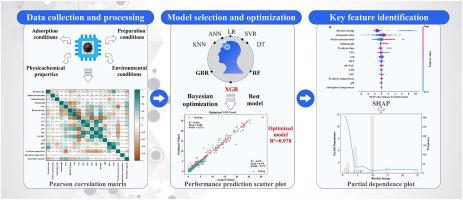利用机器学习策略预测水体中生物炭对氨氮的吸附:模型优化和关键特征变量分析。
IF 7.7
2区 环境科学与生态学
Q1 ENVIRONMENTAL SCIENCES
引用次数: 0
摘要
生物炭吸附技术已广泛应用于水体中氨氮的去除。然而,现有的吸附效率预测方法往往缺乏足够的准确性和实用性。利用XGB、LR、KNN、DT、RF、GBR、SVR和ANN等8种机器学习模型对氨氮的吸附效率进行了预测。评估使用了一个包含770个生物炭吸附氨氮实例的数据集。系统地比较了模型的预测性能,并采用交叉验证来提高模型的泛化能力,从而选择出性能最好的模型。对选取的模型参数进行贝叶斯优化,提高预测精度。贝叶斯优化后的XGB模型预测效果最好,决定系数(R2)为0.978。其他模型的R2值在0.556 (LR) ~ 0.927 (RF)之间。利用SHAP分析法确定了影响氨氮吸附效率的关键因素。影响因素包括生物炭用量、吸附时间、初始氨氮浓度、溶液pH、热解时间和O%。通过局部依赖图进一步确定其最优范围。本研究开发了一种可靠的机器学习工具,用于准确预测氨氮吸附效率。为优化生物炭的制备工艺和吸附条件提供了思路,有助于生物炭在处理水体氨氮污染中的实际应用。本文章由计算机程序翻译,如有差异,请以英文原文为准。

Predicting the adsorption of ammonia nitrogen by biochar in water bodies using machine learning strategies: Model optimization and analysis of key characteristic variables
Biochar adsorption technology has been widely used to remove ammonia nitrogen from water bodies. However, existing methods for predicting adsorption efficiency often lack sufficient accuracy and practical usability. This study evaluated eight machine learning models, including XGB, LR, KNN, DT, RF, GBR, SVR, and ANN, to predict the adsorption efficiency of ammonia nitrogen. The evaluation utilized a dataset comprising 770 instances of ammonia nitrogen adsorption by biochar. The models' prediction performances were systematically compared, and cross-validation was applied to enhance their generalization ability, leading to the selection of the best-performing model. The selected model's parameters were further optimized using Bayesian optimization to improve the prediction accuracy. The Bayesian-optimized XGB model achieved the highest predictive performance, with a coefficient of determination (R2) of 0.978. The R2 values of the other models ranged from 0.556 (LR) to 0.927 (RF). Key factors influencing ammonia nitrogen adsorption efficiency were identified using SHAP analysis. These factors included biochar dosage, adsorption time, initial ammonia nitrogen concentration, solution pH, pyrolysis time, and O%. Their optimal ranges were further determined through partial dependency plots. This study developed a reliable machine learning tool for accurately predicting ammonia nitrogen adsorption efficiency. Additionally, it provided insights into optimizing the preparation processes and adsorption conditions of biochar, contributing to its practical application in treating ammonia nitrogen pollution in water bodies.
求助全文
通过发布文献求助,成功后即可免费获取论文全文。
去求助
来源期刊

Environmental Research
环境科学-公共卫生、环境卫生与职业卫生
CiteScore
12.60
自引率
8.40%
发文量
2480
审稿时长
4.7 months
期刊介绍:
The Environmental Research journal presents a broad range of interdisciplinary research, focused on addressing worldwide environmental concerns and featuring innovative findings. Our publication strives to explore relevant anthropogenic issues across various environmental sectors, showcasing practical applications in real-life settings.
 求助内容:
求助内容: 应助结果提醒方式:
应助结果提醒方式:


